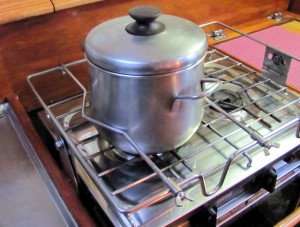
Practical boat tips –
Stove Safety
Raising my children aboard a yacht from age two and three meant stove safety was critically important. Many times while Jack and I managed the ship the boys were left alone below, and because we have always used gas, the conveniently located shut off valve made it quick and easy to turn it off every time after using the stove. This no-hassle routine gave us peace of mind.
For many years Banyandah’s two gas cylinders were stowed on deck directly above the turn off valve under the deck head, but during her rebirth the gas cylinders were relocated right aft in a special locker and now the turn off valve lives in a lift-up cupboard handy to the stove. We also turn the gas bottle off whenever we leave the boat. Note that if using a solenoid shut off valve, they can fail and remain closed. One unfortunate family we know ate cold food from the Galapagos to the Marquesas while bitterly complaining about slack Panama boat boys, when in fact their cylinder was actually full!
Check gas connection joints with a squirt of soapy water out a spray bottle. We keep one handy in the aft locker alongside the cylinders. Note also that the flexible gas line is susceptible to wear or being crushed.
I find it safer to have the stove fixed when the boat is stationary. Then there’s no risk of the stove being accidentally tipped when a landlubber comes on board or the children go a bit crazy. And it’s easier when opening the oven door. To prevent the stove swinging, a simple slide bolt can be fitted at the bottom.
Deep fiddles and locking bars secure pans in most conditions, but a rogue sea can still send a pan flying. I’ve had a tall 3 L saucepan with open handles on board for forty years. It’s my most used pan, really safe for liquids, and particularly good as the lid sits deeply into the pan rim. When extra security is needed, in addition to securing the locking bars, I clip its handles to the front and back fiddles using short shock-cords with metal hooks.
The cook’s safety strap should not pass across the front of the stove so as not to trap the cook in front of hot fat or boiling liquid. That means when at sea I always work from one side, and being right handed I find it convenient that Banyandah’s stove is to the right of the work bench with the sink to the left. Heavy pans are then always lifted with my stronger hand.
Many more photos and tips in Practical Boat Bits and Tips by Jude Binder
– Jude Binder

